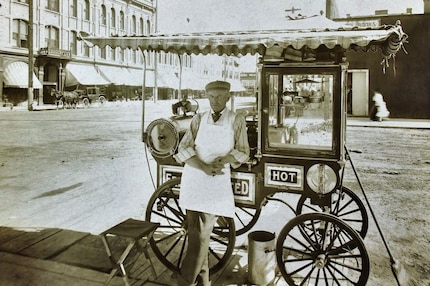
Background information
«Sometimes it seems like all that’s showing in cinemas are sequels, prequels and remakes»
by Carolin Teufelberger

Popcorn and the cinema go hand in hand. Take away the puffed corn and many would deem the experience incomplete. How did this symbiosis between cinema and snack come to be?
The cinema. A moderately motivated employee is stationed at the cash register. Next to him, a sizeable glass box. Inside, umpteen clumps of white bounce about: popcorn. Small, medium and large bags line the counter. «Expensive», «more expensive» and «most expensive». Red and white elements decorate the thick paper. The smell of butter wafts through the air. «One medium bag of popcorn, please.» The guest's hand reaches into the bag before she’s done paying. Just like that, a fifth of the salty snack has already found its way onto the ground. She consumes the remaining four fifths during the pre-movie ads. By the time the movie begins, all that’s left of the popcorn is the butter and salt residue on her fingers.
Popcorn is part and parcel of the cinema experience, no matter the movie – be it a shallow comedy, way-too-long thriller or family-friendly Disney movie. The cinema just isn’t quite right without it. But popcorn and the movies didn’t always go hand in hand. In fact, it was initially frowned upon by cinema operators.
Popcorn was most likely brought to New England in the Northeastern United States by traders from South America in the early 19th century. Popped corn had already been cultivated in South America for a long time. After just a few years, popcorn became a common snack in North America. In 1848, its name even found its way into the «Dictionary of Americanisms». Popcorn could be found at fairs, in circuses and on the streets. The invention of the steam-powered portable popcorn machine by Charles Cretor in 1885 further increased the snack food’s popularity. It was now easy to make on the go. Not to mention the fact that its scent filled the streets, attracting new customers.

With that, popcorn could be found everywhere – except in movie theatres. This was fitting given the distinguished establishment that the cinema was with its red carpets and beautiful armchairs. Eating during performances was prohibited not only because of the mess it would make, but also because of the distraction chewing noises would pose. In the early days of cinema, audiences also had to know how to read – a skill that wasn’t so common at the time. Silent films were accompanied by live music, but intertitles were also used to tell part of the story. And so, the cinema remained the preserve of the rich, educated class, who were happy to forgo snacks.
The fact that the cinema changed from an elitist establishment to one for all social classes is mainly due to the introduction of the sound film, but also due to the Great Depression in the 1930s. The cinema became that little bit of luxury that most people were just about able to afford. A bag of popcorn, which cost between 5 and 10 cents in the United States at the time, was also within the budget. Street vendors immediately recognised the potential and set up shop in front of cinemas with their mobile popcorn machines.
After countless bags of popcorn were smuggled into the auditorium, cinema operators gave in and allowed the street vendors to sell directly in the entrance hall – for a small fee, of course. It didn’t take long for cinema operators to realise they could multiply their profits simply by cutting out the middle man. And so, the operators themselves started selling popcorn. For many cinemas, this snack was actually a lifeline during the financially difficult period of the Great Depression.
During the Second World War is when popcorn and the cinema became united for good. As sugar became a scarce commodity and was rationed, sweet snacks became less and less available. Salty popcorn, on the other hand, remained – with much less competition. In 1945, nearly half of the popcorn consumed in the United States was eaten in movie theatres.
Here in Switzerland, it’s also difficult to imagine the cinema – or at least massive multiplexes – without popcorn. According to the NZZ, which quotes a cinema operator, the snack bar is much more profitable than ticket sales. Unlike ticket sales, snack bar revenue doesn’t have to be shared with the film distributor. Popcorn, which is very cheap to buy, can be sold at a huge margin. And its saltiness ensures that drinks are bought with it. Not to mention that in Switzerland, there’s an extra break halfway through the movie. It’s the perfect time to go to the restroom – or raid the snack bar again.
To this day, you’d be hard-pressed to find popcorn in arthouses or cinemas with a curated programme. Until just a few years ago, the Neugass Kino AG cinemas didn’t offer popcorn, either. «We had made up our minds about not wanting a popcorn machine – above all, because of the odour emitted while making it, which would inevitably also seep into the auditorium. And for a long time, there frankly wasn’t any pre-popped, pre-packaged popcorn that lived up to our expectations,» explains Daniela Küttel, head of operations and member of the management team. Popcorn’s smell, of all things, was deemed a problem.
The very same smell that, in the early days, played such an important role in cultivating its popularity.
My life in a nutshell? On a quest to broaden my horizon. I love discovering and learning new skills and I see a chance to experience something new in everything – be it travelling, reading, cooking, movies or DIY.
Interesting facts about products, behind-the-scenes looks at manufacturers and deep-dives on interesting people.
Show all